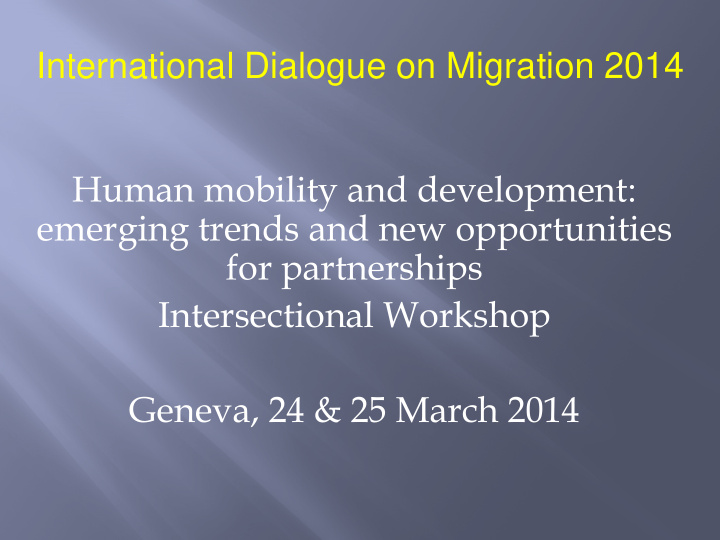



International Dialogue on Migration 2014 Human mobility and development: emerging trends and new opportunities for partnerships Intersectional Workshop Geneva, 24 & 25 March 2014
By Moisés Uamusse AMIMO Secretary General of Association of Mozambican Miners - AMIMO
In 1867 diamonds were discovered in Kimberly, South Africa and rumours traveled among the surrounding countries; Men from various neighbouring countries flocked to South Africa to work in the mines, most by foot; Migration started changing the lives of the families and produced remittances to the governments.
My father was born in 1906 and took his first venture to the mines by foot in 1927, one year before the signing of the controlled hiring labour force agreement between Portugal and Transvaal in 1928; He married in 1930 and had 12 children, among them, ten men and two women. I am the youngest, born in 1960; Among the ten sons, six worked as miners in South Africa to fill these jobs, due to the short supply of local labour force within this industry.
In 1990, I joined the SA mining industry and, like others, followed the recruitment procedures and medical observations under very difficult conditions. We lived in the “Hostels”, shared culture and exchanged information with miners from all the countries that supplied labour in the mining industry, and I learnt that migrant miners are not entitled to pension fund;
Mining (gold, platinum, uranium, • coal etc.) is dug in underground, where the geothermal gradient rises every time the mine goes deep; The breathing is supported by • machinery that produces air on surface and transported by pipes to underground; Despite several galleries, the • mine only has a single shaft for in and out;
In drilling and blasting operations, the mineworkers inhale the silica’s powder that keeps on flying, which then can develop into tuberculosis and silicosis;
High HIV prevalence & vulnerability among mineworkers (PLWHA > 20-30 times more likely to develop TB) Mining sector in Southern Africa has the highest concentration of TB in the world (20 times the global average) 30% of mine-workforce are international migrants; 60% internal migrants.
In the mines we used a uniform underground language for communication, which was taught during induction and training; On the surface we lived by nationalities and there was a great language barrier to communicate with locals, including outside hostels, hence we used “Fanagaló” in town; I decided to learn English and break the barrier;
The need to defend the miners rights grew, and, together with other friends, we decided to form an Association. Motivations: Mozambican miners are not entitled to pension i. fund after work abroad; The Trade Unions assistance to migrant miners ii. does not cross the borders; The migrant miners health and social benefit iii. issues are not fully addressed.
In 1996, the dream to form an Association became true and AMIMO was registered in Mozambique in 1998. AMIMO The mission is to restore Reg. nº 92f48Lq-1/98 hope to migrant mineworkers and families
Services: Assisting Counselling Supporting Lobbying Advocacy.
AMIMO gains credibility among miners AMIMO maps ex-miners; Selfish experience shows no success; In 2006, a dream to form regional organization comes true; In 2010 we convened 1st Regional Miners Association meeting.
- Problems are similar across the Southern Africa Region; Issues needing to be addressed: – – Social Welfare, Health and Social Benefits; Limited support; – – Mines CSR – Governments – CSOs in the region; There has been little or no – involvement in the forums GDP
2nd Regional Meeting approves SAMA Constitition in 2010 Reg. Nº 2011/283 SAMA represented by four countries: Lesotho, Swaziland, Mozambique and South Africa.
Lack of information on migration rights; • Illiteracy & language barriers affect migrant miners; • Xenophobia; • Lack of information regarding miners rights; • Low attention paid to migrant miners by local governments. • Continuity of care in Moz. and high burden of HIV and TB • among Miners returning home.
Strengthening miners´ voice through SAMA; Influencing policies through strong advocacy; Local governments start to realize miners voices and sign Regional TB Declaration in the Mining Sector 2012;
SAMA in partnership with the World Bank advocated for the harmonization of TB treatment among miners in the selected four countries (Lesotho, Mozambique, S.Africa & Swaziland); In the same countries, SAMA / SAT are facilitating regional dialogue on miners access to social security benefits.
Recommend
More recommend